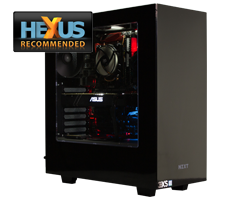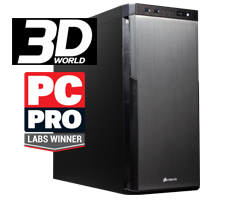SCANZONE
03.03.17 | ISSUE 48
As 2017 gets properly underway AMD has lifted the curtain on its first Ryzen CPUs that it’s been teasing us about for the last few months. Read to find out what makes the new chips special and how they stack up against Intel’s best. We’ve also got news on a massive update to NVIDIA’s Quadro cards for graphics workstations.

1. AMD Ryzen 7 1700X review
It’s been a long time coming, but AMD is finally back with an all-new CPU architecture. Codenamed Zen, the first three CPUs have just been launched, the Ryzen 7 1700, 1700X and 1800X.
Designed from the ground-up using a state of the art 14nm manufacturing process, Ryzen 7 CPUs feature some nifty new features such as Precision Boost that helps adjust the clock frequency in 25MHz steps on the fly and Extended Frequency Range that is an automated overclocking system. There’s also a fine-grained Pure Power management system to cut power consumption. Finally, Ryzen 7 CPUs have a Neural Net Prediction processor inside, which learns which applications you run most often and then pre-loads the most commonly used CPU instructions, plus Smart Prefetch caching algorithms.
Spec wise all three Ryzen 7 CPUs use the new AM4 socket and are 8-core models, with the ability to process 16 threads thanks to SMT technology. The cheapest model, the 1700 runs at between 3GHz and 3.7GHz, the mid-range 1700X at between 3.4GHz and 3.8GHz and the high-end 1800X at between 3.6GHz and 4GHz. All three CPUs sport 16 PCI-E 3.0 lanes plus a further 4 lanes for a PCI-E NVME SSD and dual-channel DDR4 controller that supports up to 2667MHz RAM.
On one hand this combination of high number of cores puts the Ryzen 7 CPUs up against Intel’s Broadwell E based CPUs such as the Core i7 6800K. But in terms of the number of PCI-E lanes and memory bandwidth and memory capacity Ryzen 7 is more like Intel’s Kaby Lake CPUs such as the Core i7 7700K.
At the time of writing AMD had only sent us the Ryzen 7 1700X to test, which we put through its paces in an Asus Prime X370-Pro motherboard. This is based on the AMD X370 chipset, the high-end chipset from a big range that AMD is planning on releasing for Ryzen. Other chipsets include the mid-range B350 which loses support for SLI and CrossFire plus the A320 which doesn’t support overclocking. You can expect to see quite a wide variety of Socket AM4 motherboards from the usual suspects over the coming weeks.
In our own testing the Ryzen 7 1700X proved very interesting, providing similar performance to a Broadwell E Core i7 6800K CPU in single-threaded applications, showing that after 11 years AMD has nearly caught up with Intel in terms of raw IPC (instructions per clock). As a result, the Ryzen 7 1700X performed very well in multithreaded applications such as the video encoder Handbrake and Cinebench 3D rendering test, beating Broadwell E conclusively, by as much as 35%. If the performance isn’t enough for you, you can overclock the Ryzen 7 1700X as well, with our sample happily clocking from 3.4 to 4GHz to yield an extra 14% more performance. However, in the computational fluid dynamics benchmark Euler3D, SPECviewperf and several games Ryzen was noticeably slower than Intel’s similarly priced CPUs.
The variable performance we saw means that the Ryzen 7 1700X is truly amazing at some tasks such as video encoding, but not great at everything, so it’s worth carefully thinking about what you use your PC for. This is especially true for workstations as Ryzen does not support as many PCI-E lanes or as much memory as Broadwell E.
Scan carries the full range of Ryzen 7 CPUs and AM4 motherboards plus a variety of gaming PCs based on the new platform.

2. NVIDIA Quadro’s gets the Pascal treatment
NVIDIA upgraded its two high-end professional Quadro cards, the P5000 and P6000, to the Pascal architecture a few months ago, and it is now doing the same to the rest of the Quadro range.
As you might expect, the new Pascal based Quadros all start with the letter P, with five new cards coming out over the next few weeks. These range from cards designed for basic 2D applications all the way up to 3D and VR content creation. Here’s a quick look at the new range from top to bottom.
The P4000 replaces the older M4000, sticking with 8GB of GDDR5 RAM, but increasing the core count from to 1664 to 1792. In real world terms this makes the P4000 around 30 – 50% faster than the M4000 in applications such as SolidWorks and Autodesk VRED. The P4000 is also VR Ready so is the most affordable VR Ready Quadro card, giving superior performance in VR applications than the previous generation M5000 at a much lower price.
Next down the stack is the P2000, which replaces the M2000. The P2000 has 5GB of GDDR5 memory plus 1024 cores, so is a massive upgrade over the M2000, which has 4GB of memory and 768 cores, providing around 60% more performance depending on the application.
Meanwhile the K1200 is be replaced by the P1000, boosting its core count from 512 to 640, although it sticks with the same 4GB of GDDR5 memory. Unfortunately, we haven’t been able to get our hands on a P1000 yet so don’t have any benchmark results to share, however from the specs alone it’s clear that the P1000 will be significantly faster than the K1200.
There are also two new entry-level 2D cards, the P600, which has a similar spec to the older K620 but supports four displays natively plus the P400, which replaces the old K420. The new P400 has 64 more cores than the K420 so it should be considerably faster.
You can view the whole range of Quadro graphics cards and 3XS graphics workstations using the new cards on our website.

3. NVIDIA Quadro GP100 announced
The first Pascal GPU to see the light of day was the mighty Tesla P100, which is found inside the DGX-1 deep learning supercomputer. However, being a Tesla card the P100 does not have any graphics outputs and is passively cooled so can’t be installed in a conventional workstation.
NVIDIA has therefore taken the unusual step of creating a Quadro card using the P100 GPU. Known as the Quadro GP100, the new card sports 3584 CUDA cores plus 16GB of HBM2 memory. These specs make the GP100 an interesting proposition. For instance, the Quadro P6000 has 3840 cores and 24GB of GDDR5 memory, so for visualisation tasks and rendering will be faster. However, for compute tasks such as deep learning the GP100 should be considerably faster thanks to the ability of the underlying P100 GPU to process FP16 instructions and the much higher bandwidth of HBM2 memory.
We don’t have a price for the Quadro QP100 yet, but are expecting stock to arrive sometime in March. Keep an eye out on the Scan Pro Graphics homepage for more news.

"A stellar gaming experience"
The 3XS Gamer Aura is a high-end gaming PC that is part of our Powered by Asus range, incorporating the latest Asus technologies such as Aura RGB lighting on the motherboard and graphics card. Aura is fully customisable by the end user with dozens of different schemes and millions of colours.
HEXUS took a look at the Gamer Aura, giving it a Recommended Award and writing that ‘The 3XS Gamer Aura is a competent, streamlined-looking piece of kit. The 3XS Gamer Aura has the horsepower to deliver solid framerates with high-quality settings. The 3XS Gamer Aura scores well in every relevant benchmark. Pairing a seventh-gen Core i5 processor to 16GB of DDR4 memory, a swift M.2 SSD and a GeForce GTX 1070 graphics card delivers a stellar gaming experience. Framerates are excellent the ubiquitous FHD resolution, and there's enough power to deliver in excess of 60 frames per second at a QHD resolution in most titles.’
You can read the 3XS Gamer Aura review on HEXUS and configure the Gamer Aura online.

"You get a lot of workstation for your money"
The Scan 3XS Classic 3D is a graphics workstations designed for 3D modelling, basic animation, texturing and rendering such as 3DS Max, Cinema 4D, Creative Cloud and SolidWorks.
We sent a system based around the Intel Core i7 6950X CPU with AMD Radeon Pro WX7100 graphics to 3D World magazine, which gave the system a Best in Class Award and wrote that the Classic 3D provided ‘One of the best scores we've seen for a single-socket system. Modelling is also excellent. Its modelling abilities are excellent and the ten cores make light work of rendering. Thanks to the value offered by AMD's rejuvenated graphics offering, you get a lot of workstation for your money.’
You can read the full review in the March issue of 3D World and configure the Classic 3D online.

"State-of-the-art content creation kit for the money"
We also sent a version of the Classic 3D to PC Pro’s annual group test of graphics workstations. This version also featured the Intel Core i7 6950X CPU but upgraded the graphics to the much more powerful NVIDIA Quadro P5000 card.
We’ve very proud to announce that the Classic 3D won the group test, beating the other 7 systems to take home the Labs Winner Award. PC Pro had this to say about the system ‘Whether you are modelling 3D, image editing or video editing the 3XS has what it takes. The very competitive pricing and powerful components make the Classic 3D our top choice this month. State-of-the-art content creation kit for the money’.
You can read the full review in the April issue of PC Pro and configure the Classic 3D online.